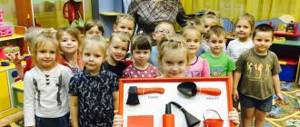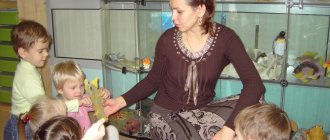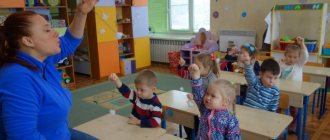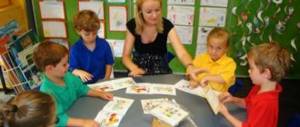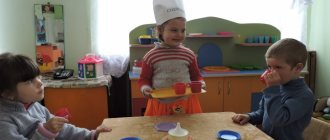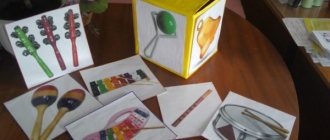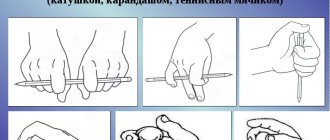Classification of types of gaming activities
There are several approaches to dividing fun into types. In preschool educational institutions, it is customary to use a classification that combines factors of content, degrees of independence and form of organization.
Didactic
These are fun games that involve
- a clear framework for the activities of each participant,
- strict rules,
- goal and inevitable end result.
These games are used to introduce new material (for example, an experimental game to determine the speed of snow melting at different temperatures), to consolidate knowledge (for example, to practice addition within 10, children put together puzzles in which the missing elements are addends or sums).
Types of didactic games
Didactic games are grouped according to several principles.
By content
- Mathematical (in some sources they are called logical). These games are used in the preparatory group, for example, to consolidate ideas about time, simple arithmetic operations, quantity, spatial arrangement of objects, etc. These include games with counting sticks and geometric shapes.
- Sensory. When working with children 6–7 years old, such didactic games are used infrequently, since their main purpose—familiarization with colors, shapes, and sizes—has already been accomplished at earlier age stages. Therefore, sensory games are mainly used to master the palette of color shades, as well as to consider topics on familiarization with the surrounding world related to the study of physical phenomena.
- Speech. They are used to form and consolidate ideas about words and sentences, the grammatical structure of the language and enrich vocabulary.
- Musical.
Used for the development of hearing, senses and src=»https://rucheyok.ru/wp-content/uploads/2019/01/mc15zjb5.jpg» class=»aligncenter» width=»600″ height=»380″[/img ] Music games often include elements of choreography - Natural history, often in the nature of experiments. They are used when getting to know objects of living and inanimate nature. For example, with water in different states of aggregation.
- To get acquainted with the world around you. In the preparatory group, this is mainly associated with mastering the basic features of different professions.
- Business games. Many methodologists do not distinguish this type, since they classify business games as forms of organizing educational activities. And indeed, even in terms of time, such fun lasts not 15 minutes, but 30. Thus, we can conclude that a business game is not part of the lesson, but a form of its organization.
Based on didactic material
This principle allows us to divide games into:
- fun with toys and objects (for example, story games about wild animals, which are played by natural materials - chestnuts, acorns),
- desktop-printed (lotto, dominoes, puzzles),
- interactive, using technical teaching aids (such games are possible in groups that have an interactive board, as well as if the teacher has didactic materials for conducting),
- verbal (for example, in the game “Sound Caps”, children learn to compose forward and backward syllables when, moving in a cap with a vowel attached to it, they stop at a signal near a consonant lying on the floor and form a syllable with it).
Sound caps can be replaced with a field of flowers
This is interesting. In a number of methodological literature, games with objects and toys are classified as part of the group of role-playing games, which, in turn, are part of theatrical entertainment. However, based on the goals and objectives of these games, it would still be more correct to adhere to the classification based on the accented content component, that is, educational in games with objects and developing in role-playing games.
Video: didactic speech game “Tags”
Role-playing
At 6–7 years old, this type of play is represented not by simple actions with toys, but by fun-manipulative activities that require the child to apply existing gaming and social experience (for example, interpersonal relationships in the family). Role-playing games in the preparatory group are divided into subgroups:
- household (help children consolidate ideas about status roles in the family),
- professional (allows children to take on the roles of doctor, teacher, salesman to show initiative),
Professional games awaken children's interest in different specialties
- games on patriotic themes (mostly games with a heroic meaning, which boys usually play, for example, war games),
- games to embody artistic plots (for example, children enjoy repeating stories from cartoons, reshaping plot twists at their discretion).
This is interesting. In the preparatory group, role-playing games are usually the basis for children’s independent activities.
Video: role-playing game “Train” in the preparatory group
Movable
Games of this type are among the most favorite among older preschoolers, who are characterized by increased activity. Outdoor games help improve health, develop dexterity, attentiveness and are an excellent way to change the type of activity from passive to active or vice versa. Can be:
- imitative (when children need to move “like a duck”, run “like a hare”, etc.),
- plot (created based on stories from fairy tales, legends, for example, “Geese-Swans”),
- with rules (“Tag”, “Hide and Seek”, etc., that is, games without a plot, but with rules),
- competitive (in some sources they are called sports, since they include competitions in running, including skiing and jumping),
- round dances (most folk entertainments belong to this type),
- with certain tasks, that is, in order to fulfill the conditions of the game, it is necessary to perform a whole series of game actions (these games are introduced at an older age as one of the preparatory work methods for school; in kindergarten, such fun is carried out in the form of family competitions - with moms and dads).
Outdoor games are very effective at switching children’s attention from one activity to another.
Video: outdoor game “Lion”
Theatrical
These games can be divided into two large groups:
- dramatization (when a child acts as an “artist”, creating an image using verbal and non-verbal means of expression),
- directorial (when the baby acts as an organizer of “artists”, that is, flat or three-dimensional toys, dolls).
Dramatizations
Types of dramatization are:
- imitations (of people, animals, fairy tale characters),
- role-playing scenes (children act out dialogues based on some text),
In the preparatory group, role-playing scenes should not be written out completely; it is necessary to leave the children the opportunity to come up with ideas
- dramatizations (such fun is usually carried out after studying literary works, children theatrically present excerpts of the plot),
- improvisation (when guys get a role and a situation in which the hero finds himself, but without instructions regarding the character’s words and actions).
Director's
Such games are divided into several types, based on the variety of types of theater that children are introduced to:
- tabletop (when the “artists” are, for example, chestnuts or acorns),
- puppet (finger toys, puppets, bibabo),
- fist (when children show stories using their fists painted or dressed in fabric),
- canned, made from cups (the characters are made from waste material).
This is interesting. A number of methodologists highlight another type of games in preschool educational institutions: leisure games, that is, those that are organized in the process of entertainment and walks. These include folk games, as well as some outdoor ones.
Children are familiar with the tabletop theater from the first junior group
Finger games-exercises
Finger gymnastics is often called finger games. Therefore, it is appropriate to identify this gaming activity as a separate type. The main purpose of finger exercises is to train fine motor skills, in the context of working with older preschool children; this is directly related to preparing the hand for writing.
Card file of games in the preparatory group
For the convenience of drawing up notes on a lesson or leisure activity, games are included in separate calendar plans for each type of fun. The teacher, having a complete list of fun activities, selects them to suit the skill, ability, stage of the lesson or topic being practiced. The last criterion is the most productive.
Table: example of planning play activities in a preparatory group
| Topic (or stage of work in class) | Type of game | Name | Goals | Progress of the game |
| Any (mainly lexical, that is, related to vocabulary replenishment) | Didactic | "Field of Dreams" |
| Children quickly answer questions from the qualifying round. So the first three are invited to the game, who guess the word by letter, after turning the reel. Based on the results of the game of three triples, the final is held, and then the super final with the winner. |
| Summarizing the material | Didactic | "What? Where? When?" | Children, united in a team of six people, are asked questions that they must answer in 1–2 minutes. The game goes to six points. | |
| “Precipitation” (or as a physical education break) | Movable | "Rain" |
| The “cloud” children stand in a circle with plumes in their hands. The guys run away to the music, the “rain” tries to wet them. At the leader’s signal, they gather in a round dance again, while the “rain” is playing one musical excerpt, it tries to touch the “clouds” with its plume, after the end of the musical excerpt, everyone counts together how many “clouds” the “rain” has touched. |
| Entertainment, consolidation of learned material, open lesson. | Different types of play activities | "Journey through the stations" |
| During the game, the children end up at different “stations” and play the games offered there. |
| “Bread is the head of everything” | Didactic | "Bread" |
| Children, individually or in teams, lay out a sequence of cards depicting the process of growing bread, commenting on each stage. |
| "Birds of our region" | Movable | "Crows and Sparrows" |
| The team of “sparrows” calmly flies around the site. At the “crow’s” signal, the birds must quickly sit down in their places, otherwise the “crow” will get dirty. |
| "Word-forming suffixes" | Didactic | "A look into the future" |
| The teacher gives the children a list of names from which the children form patronymics. |
| Description of the location of objects in space | Finger | "Furniture" |
| This is a chair - they sit on it (the left palm in a fist is pressed against the right, fingers extended upward). This is a table - people sit at it (the left hand is in a fist, the right open palm lies on top). Here is a bed - they are lying on it (arms bent at the elbows in front of the chest, lying one on top of the other). We put things away in the closet (imitation of folding things). We all walk for a walk (the fingers of both hands walk along the knees). |
| "Rules of etiquette" | Role-playing | "A Lesson in Politeness" |
| The fairy invites the children to role-play the following situation. One of the children portrays a grandmother, the other her grandson. A grandmother, her grandson and two children are walking towards each other through a narrow door made of cubes. The children are in a hurry, trying to squeeze through the door as quickly as possible. The rest watch the game and answer questions about the culture of behavior in this situation. All the guys draw the right conclusion: elderly and sick people, small children, people with heavy and large bags need to give way. Another group of children played out the same situation; they let the grandmother and grandson pass, but did it silently, and they themselves stopped in the aisle, creating inconvenience for those passing by. Talking about politeness again. As a result, the next group of players acts correctly. |
This is the health building
Most preschoolers are already familiar with the work of the clinic, and many have already formed a personal attitude towards it. The range of children's emotions is wide - from fear to curiosity, depending on personal experience. It is safe to say that the professions of doctor and nurse are of interest to all students in the preparatory group. On this you can build the plot-role-playing game “Hospital”.
Terribly interesting
In this case, a visit to a medical institution is not planned: it is enough to take the pupils to the nurse’s office in the kindergarten itself. Many of them had already been there for inspection.
Draw the attention of preschoolers to medical paraphernalia: a white nurse’s coat, sterile instruments for examining patients, a work desk, a calendar. Explain the importance of being a doctor, but try to emphasize the idea of maintaining health instead of treating existing diseases. This way, the atmosphere of the doctor’s office will not look intimidating, but friendly.
The main idea of the lesson is to develop a patient and attentive attitude to health issues. Children need to be made to understand that taking care of their health is part of their daily routine.
Say “ah-ah”, patient!
The scene itself can represent, for example, a medical examination. A group of children are examined by a number of doctors to enroll in school. Roles for doctors: general practitioner, dentist, surgeon and ophthalmologist. Make sure your nurse or nurse is present. The assistant can record important information on the patient's chart and assist during the examination.
Another version of the plot is with a doll, since it is better to assign the role of the patient to an inanimate object. So a group of children can transform into a council of doctors specializing in a specific problem, say, cough. Participants can suggest ways to get rid of an unpleasant illness: complete rest, regularly drinking a herbal decoction, taking lozenges, etc. You can introduce the words “patient”, “complaints”, “hurts”.
Let's play "Theater"
A new theme for classes - theatrical life - introduces children to the profession of an actor, director, screenwriter, and also reinforces the basic ideas about the course of performances. The plot-role-playing game “theater” may be familiar to most pupils of the preparatory group of kindergarten: starting from 2-3 years old, children already attend the first puppet productions created for the youngest spectators. This is how children gain basic knowledge that there is a stage, a ticket and an intermission.
However, it is important to tell class participants about the rules of behavior in the theater: about purchasing a ticket, about maintaining silence while watching a production, and about possible actions during intermission. Among the new professions for children are cloakroom attendant, bartender, and organizer of order in the hall. On the other side of the curtains, the choice of crafts is even wider. To organize a performance, it is necessary to light the stage, conduct sound, and prepare costumes. The role of the presenter, who introduces the artists and the play, is also important.
Prepare theatrical paraphernalia: a curtain, one strong lamp, a microphone, chic costumes for the actors. Guests in the hall should be dressed appropriately: for the surroundings you can offer fans, feathers, binoculars and programs.
The distribution of roles will occur naturally: children prone to public speaking will choose the profession of an artist, and more shy boys and girls will choose a place “backstage” or in the auditorium. At the same time, what is important is not the production itself on a fictitious stage, but the coordinated work of all participants.
